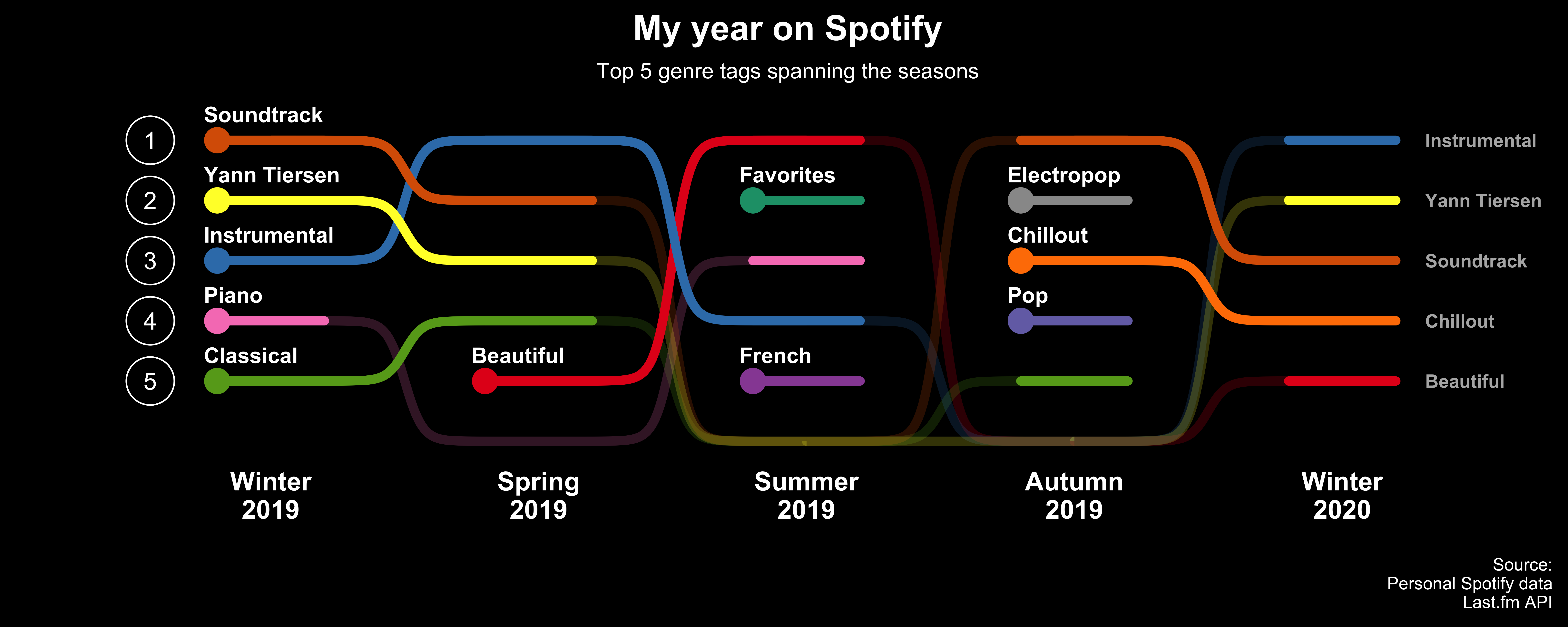https://github.com/davidsjoberg/ggbump
A geom for ggplot to create bump plots
https://github.com/davidsjoberg/ggbump
Last synced: 6 months ago
JSON representation
A geom for ggplot to create bump plots
- Host: GitHub
- URL: https://github.com/davidsjoberg/ggbump
- Owner: davidsjoberg
- License: other
- Created: 2020-02-24T10:59:44.000Z (over 5 years ago)
- Default Branch: master
- Last Pushed: 2024-04-03T16:50:03.000Z (over 1 year ago)
- Last Synced: 2024-08-03T23:23:18.178Z (over 1 year ago)
- Language: R
- Size: 13.8 MB
- Stars: 523
- Watchers: 12
- Forks: 31
- Open Issues: 15
-
Metadata Files:
- Readme: README.Rmd
- License: LICENSE
Awesome Lists containing this project
- awesome-ggplot2 - ggbump
- awesome-r-dataviz - ggbump - A geom for ggplot to create bump plots. (ggplot / Additional Plot Types)
README
---
output: github_document
---
```{r, include = FALSE}
knitr::opts_chunk$set(
collapse = TRUE,
echo = TRUE,
comment = "#>",
fig.path = "man/figures/README-",
out.width = "100%",
dpi = 800
)
```
# ggbump 
[](https://www.tidyverse.org/lifecycle/#maturing)
[](https://CRAN.R-project.org/package=ggbump)
[](https://github.com/davidsjoberg/ggbump/actions)
[](https://cranlogs.r-pkg.org/badges/ggbump)
The R package `ggbump` creates elegant bump charts in ggplot. Bump charts are good
to use to
plot ranking over time, or other examples when the path between
two nodes have no statistical significance. Also includes functions to create
custom smooth lines called sigmoid curves.
## Installation
You can install ggbump from CRAN with:
``` r
install.packages("ggbump")
```
Or the latest development version from [github](https://github.com/davidsjoberg/ggbump) with:
``` r
devtools::install_github("davidsjoberg/ggbump")
```
## Bump chart examples
Basic example:
```{r main_plot, fig.height=3, fig.width = 9, echo = FALSE, warning=FALSE, message=FALSE}
if(!require(pacman)) install.packages("pacman")
pacman::p_load(tidyverse, cowplot, wesanderson, ggbump)
df <- tibble(country = c("India", "India", "India", "Sweden", "Sweden", "Sweden", "Germany", "Germany", "Germany", "Finland", "Finland", "Finland"),
year = c(2011, 2012, 2013, 2011, 2012, 2013, 2011, 2012, 2013, 2011, 2012, 2013),
rank = c(4, 2, 2, 3, 1, 4, 2, 3, 1, 1, 4, 3))
ggplot(df, aes(year, rank, color = country)) +
geom_point(size = 7) +
geom_text(data = df %>% filter(year == min(year)),
aes(x = year - .1, label = country), size = 5, hjust = 1) +
geom_text(data = df %>% filter(year == max(year)),
aes(x = year + .1, label = country), size = 5, hjust = 0) +
geom_bump(size = 2, smooth = 8) +
scale_x_continuous(limits = c(2010.6, 2013.4),
breaks = seq(2011, 2013, 1)) +
theme_minimal_grid(font_size = 14, line_size = 0) +
theme(legend.position = "none",
panel.grid.major = element_blank()) +
labs(y = "RANK",
x = NULL) +
scale_y_reverse() +
scale_color_manual(values = wes_palette(n = 4, name = "GrandBudapest1"))
```
A more advanced example:

[Click here for code to the plot above](https://github.com/davidsjoberg/ggbump/wiki/My-year-on-Spotify)
Flags could be used instead of names:

[Click here for code to the plot above](https://github.com/davidsjoberg/ggbump/wiki/geom_bump-with-flags)
## Sigmoid curves examples
With `geom_sigmoid` you can make custom sigmoid curves:

[Click here for code to the plot above](https://github.com/davidsjoberg/ggbump/wiki/geom_sigmoid)
With `geom_sigmoid` you have the flexibility to make more complex plots:

[Click here for code to the plot above](https://github.com/davidsjoberg/tidytuesday/blob/master/2020w17/2020w17_skript.R)
# Tutorial
## Prep
Load packages and get some data with rank:
```{r data}
if(!require(pacman)) install.packages("pacman")
library(ggbump)
pacman::p_load(tidyverse, cowplot, wesanderson)
df <- tibble(country = c("India", "India", "India", "Sweden", "Sweden", "Sweden", "Germany", "Germany", "Germany", "Finland", "Finland", "Finland"),
year = c(2011, 2012, 2013, 2011, 2012, 2013, 2011, 2012, 2013, 2011, 2012, 2013),
value = c(492, 246, 246, 369, 123, 492, 246, 369, 123, 123, 492, 369))
knitr::kable(head(df))
```
To create a ranking column we use `rank` from base R. We specify `ties.method = "random"` to make sure that each country have different rankings if they have the same value.
```{r}
df <- df %>%
group_by(year) %>%
mutate(rank = rank(value, ties.method = "random")) %>%
ungroup()
knitr::kable(head(df))
```
## Make a bump chart
Most simple use case:
```{r pressure, echo = TRUE, fig.height=3, fig.width = 9}
ggplot(df, aes(year, rank, color = country)) +
geom_bump()
```
## Pimp the bump chart!
Improve the bump chart by adding:
* A point for each rank observation.
* Choose a minimal theme, I use `theme_minimal_grid()` from `cowplot`.
* Choose nice colors so it does not look generic ggplot. I use a palette from `wesanderson`.
* Remove legend and add labels at the start and end of the bumpy ride.
* Reverse the y-axis to get rank 1 at the top.
* Adjust the 'smoothness' of the lines by setting `smooth` to 8. Higher means less smooth.
```{r, fig.height=3, fig.width = 9, echo = TRUE}
ggplot(df, aes(year, rank, color = country)) +
geom_point(size = 7) +
geom_text(data = df %>% filter(year == min(year)),
aes(x = year - .1, label = country), size = 5, hjust = 1) +
geom_text(data = df %>% filter(year == max(year)),
aes(x = year + .1, label = country), size = 5, hjust = 0) +
geom_bump(size = 2, smooth = 8) +
scale_x_continuous(limits = c(2010.6, 2013.4),
breaks = seq(2011, 2013, 1)) +
theme_minimal_grid(font_size = 14, line_size = 0) +
theme(legend.position = "none",
panel.grid.major = element_blank()) +
labs(y = "RANK",
x = NULL) +
scale_y_reverse() +
scale_color_manual(values = wes_palette(n = 4, name = "GrandBudapest1"))
```
## geom_bump with factors (development version only)
You can use `geom_bump` with factors or character as x axis. Just remember to keep an eye on factor order.
```{r, fig.height=2.5, fig.width = 7, echo = TRUE}
# Original df
df <- tibble(season = c("Spring", "Pre-season", "Summer", "Season finale", "Autumn", "Winter",
"Spring", "Pre-season", "Summer", "Season finale", "Autumn", "Winter",
"Spring", "Pre-season", "Summer", "Season finale", "Autumn", "Winter",
"Spring", "Pre-season", "Summer", "Season finale", "Autumn", "Winter"),
rank = c(1, 3, 4, 2, 1, 4,
2, 4, 1, 3, 2, 3,
4, 1, 2, 4, 4, 1,
3, 2, 3, 1, 3, 2),
player = c(rep("David", 6),
rep("Anna", 6),
rep("Franz", 6),
rep("Ika", 6)))
# Create factors and order factor
df <- df %>%
mutate(season = factor(season, levels = unique(season)))
# Add manual axis labels to plot
ggplot(df, aes(season, rank, color = player)) +
geom_bump(size = 2, smooth = 20, show.legend = F) +
geom_point(size = 5, aes(shape = player)) +
theme_minimal_grid(font_size = 10, line_size = 0) +
theme(panel.grid.major = element_blank(),
axis.ticks = element_blank()) +
scale_color_manual(values = wes_palette(n = 4, name = "IsleofDogs1"))
```
## Feedback
If you find any error or have suggestions for improvements you are more than welcome to contact me :)